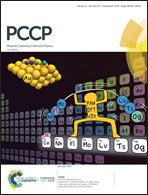Exploring the chemical nature of super-heavy main-group elements by means of efficient plane-wave density-functional theory†
Abstract
The design, implementation, and evaluation of a computationally efficient approach for exploring the chemical nature and bulk properties of the super-heavy main-group elements (SHEs) Cn–Og with nuclear charges of Z = 112–118 is described. The approach combines plane-wave density-functional theory (DFT) based on a newly devised set of projector-augmented wave potentials (PAWs) with the D3 dispersion correction, whose parameter-space is extended for this purpose. Regarding both, the fitting of the PAWs as well as the calculation of the D3 parameters, it is shown that the peculiar electronic structure of the SHEs with strong relativistic effects makes it necessary to adapt the well established computational protocols. Eventually, the methodology is tested employing various common functionals (PW91, PBE, PBE-D3, PBE0-D3, PBEsol and SCAN) by comparison to experimental and high-level results for the bulk of Cn and Og, as well as by calculating adsorption energies of Cn–Og on a gold surface and comparing these to the lighter congeners Hg–Rn as well as experimentally derived data. These tests establish that our approach provides a consistent and accurate description of the reactivity of the SHEs and is largely in excellent agreement with experimental and high-level references, and moreover underline the great relevance of dispersion interactions, as well the game-changing impact of spin–orbit coupling on SHE reactivity. Ultimately, the conducted calculations provide novel insights into the chemical behavior and nature of the SHEs, showcase the breakdown of periodic trends in the seventh period, and allow us to revisit and confirm an empirical relation between adsorption on gold and the cohesive energy.

- This article is part of the themed collection: 2019 PCCP HOT Articles


 Please wait while we load your content...
Please wait while we load your content...